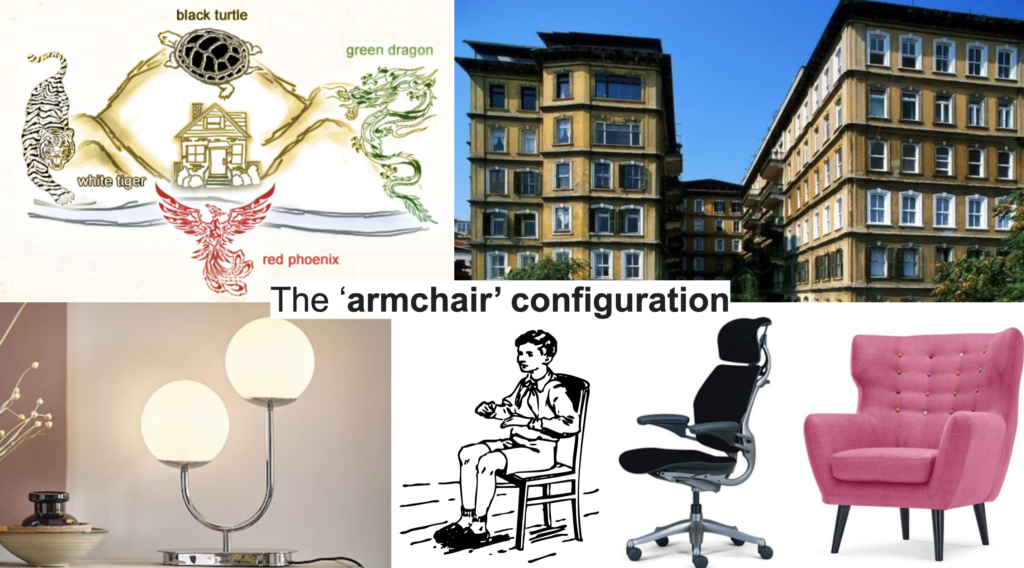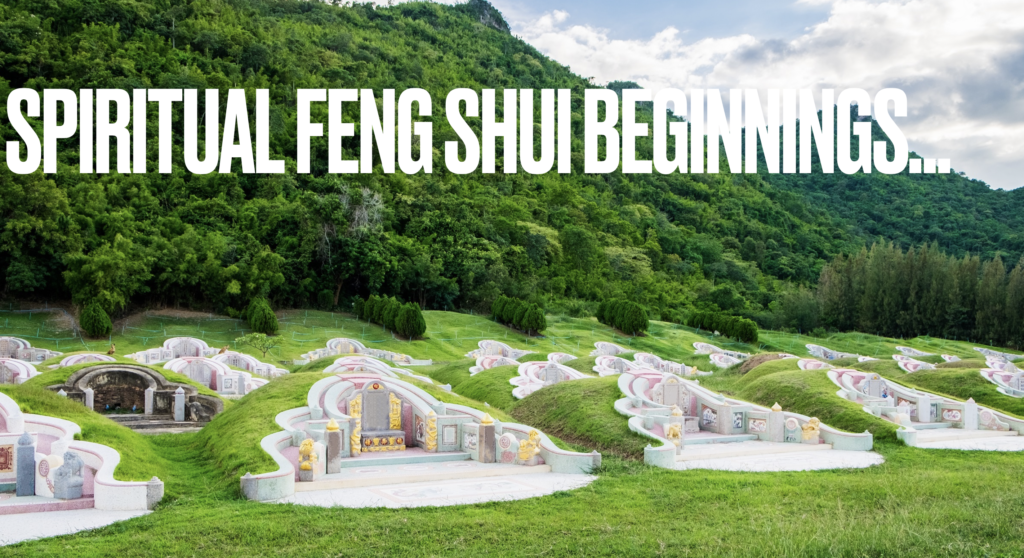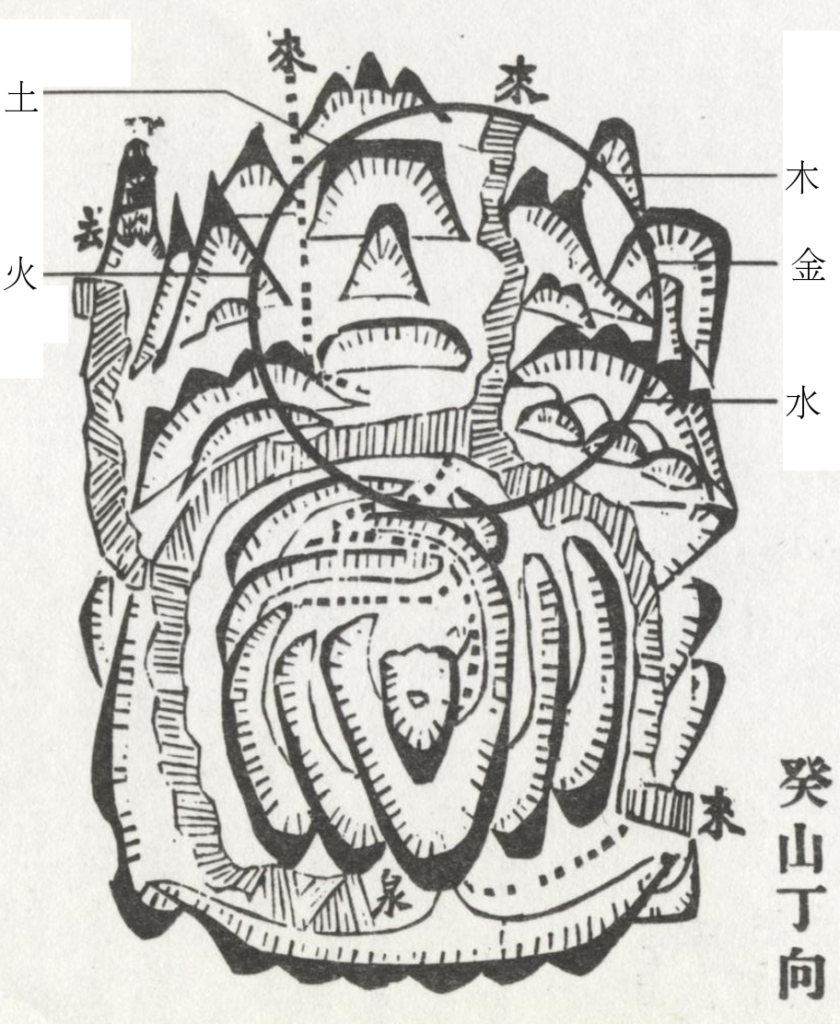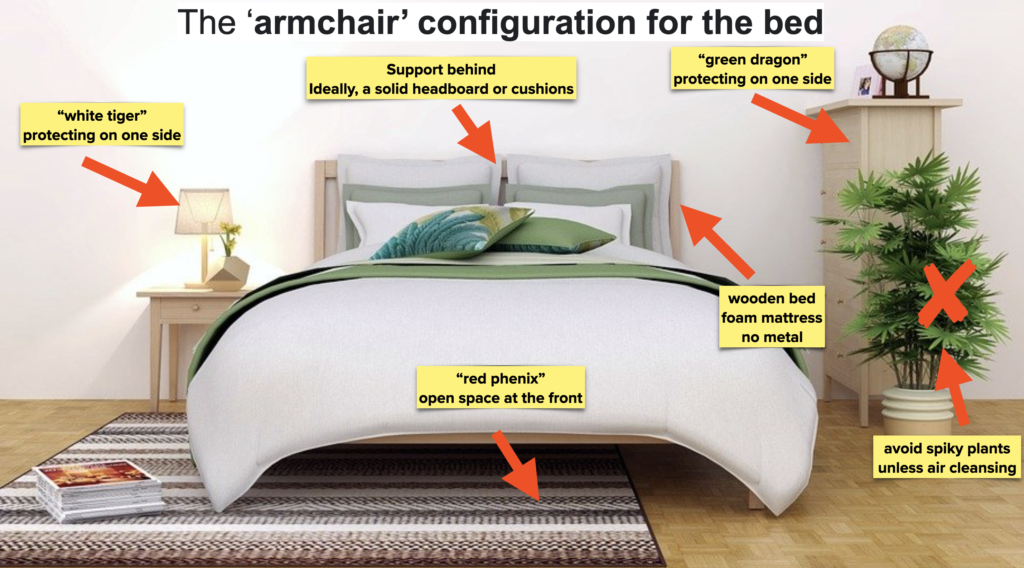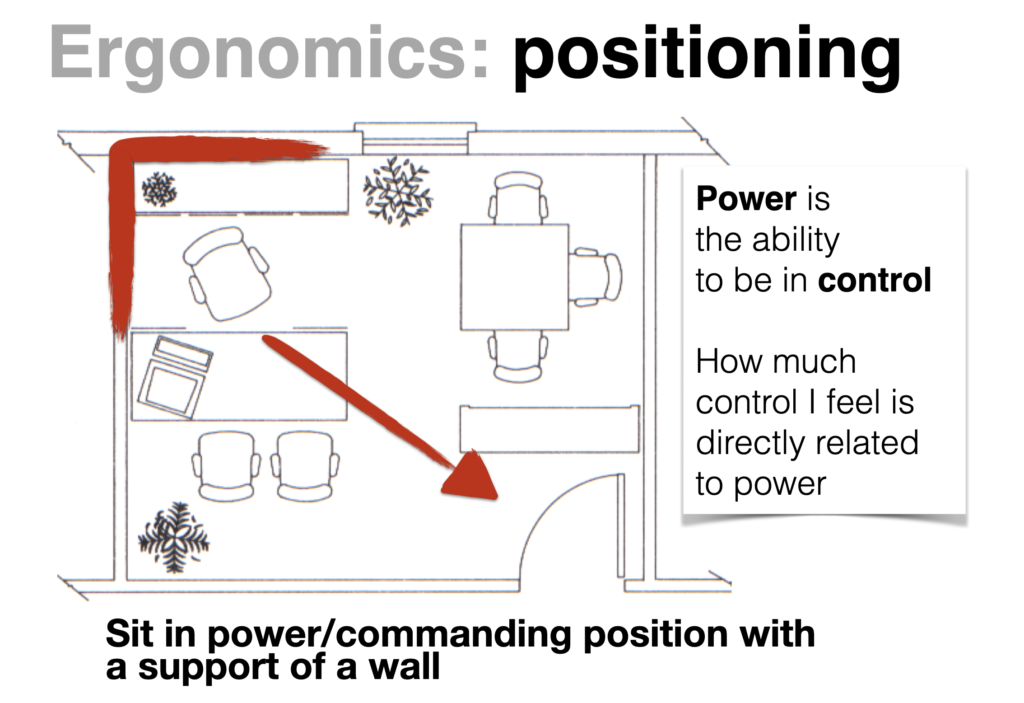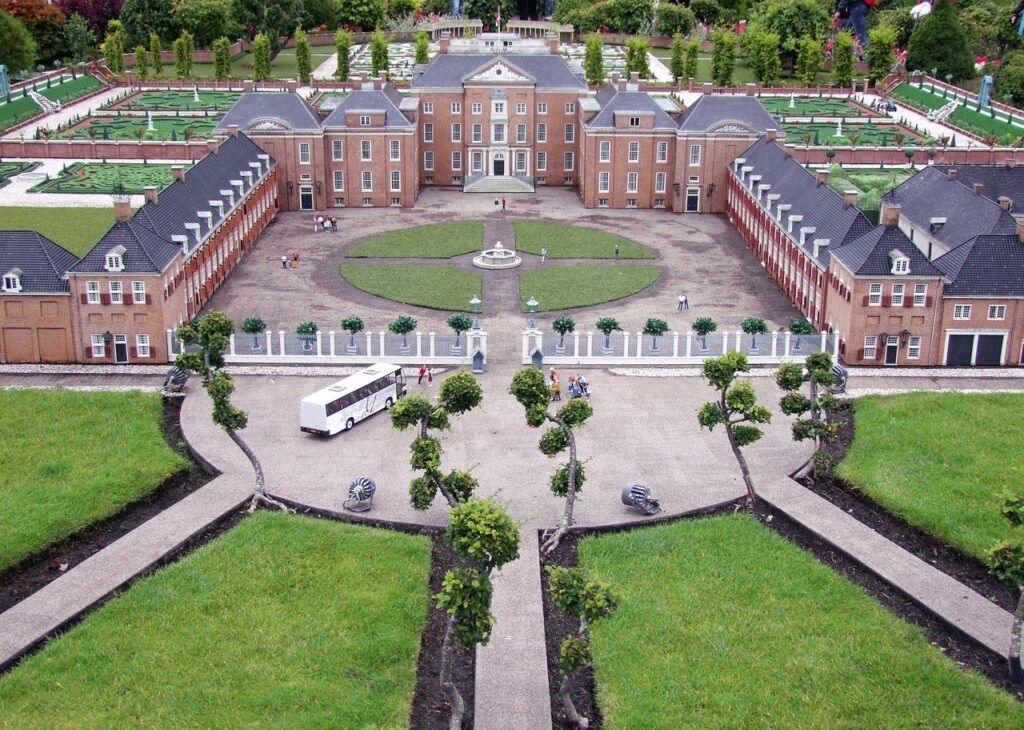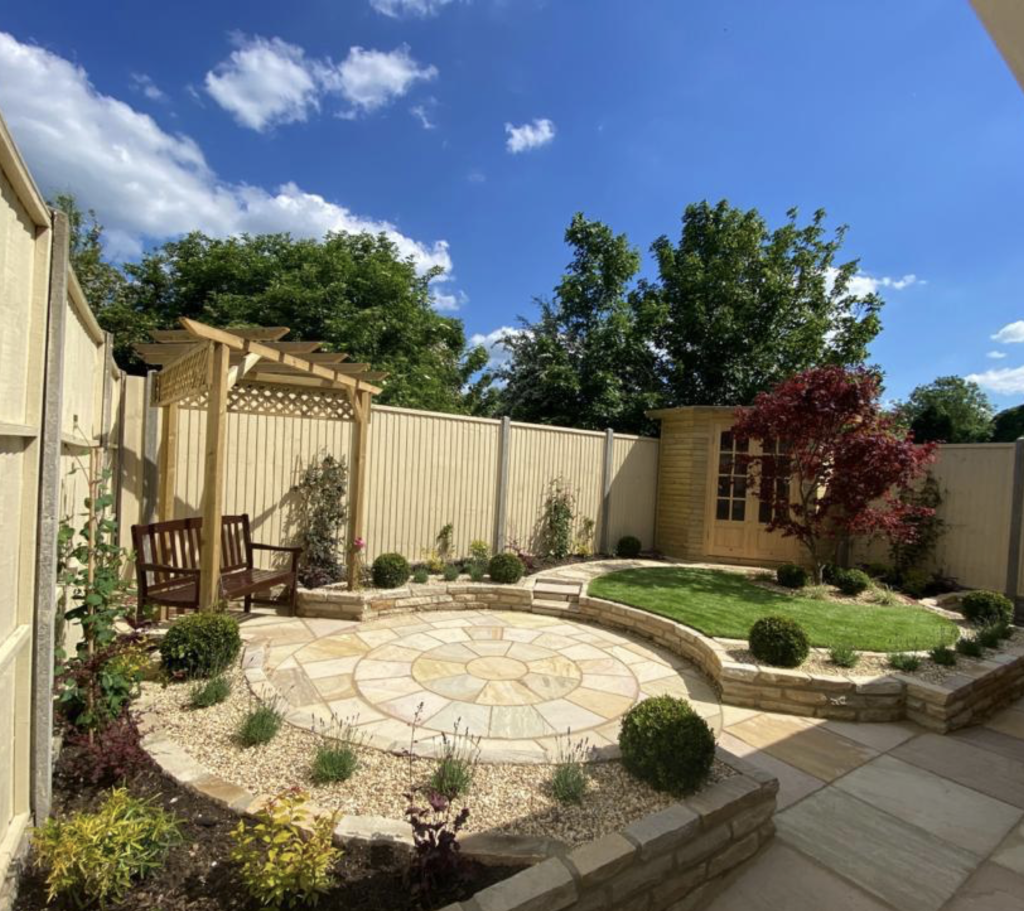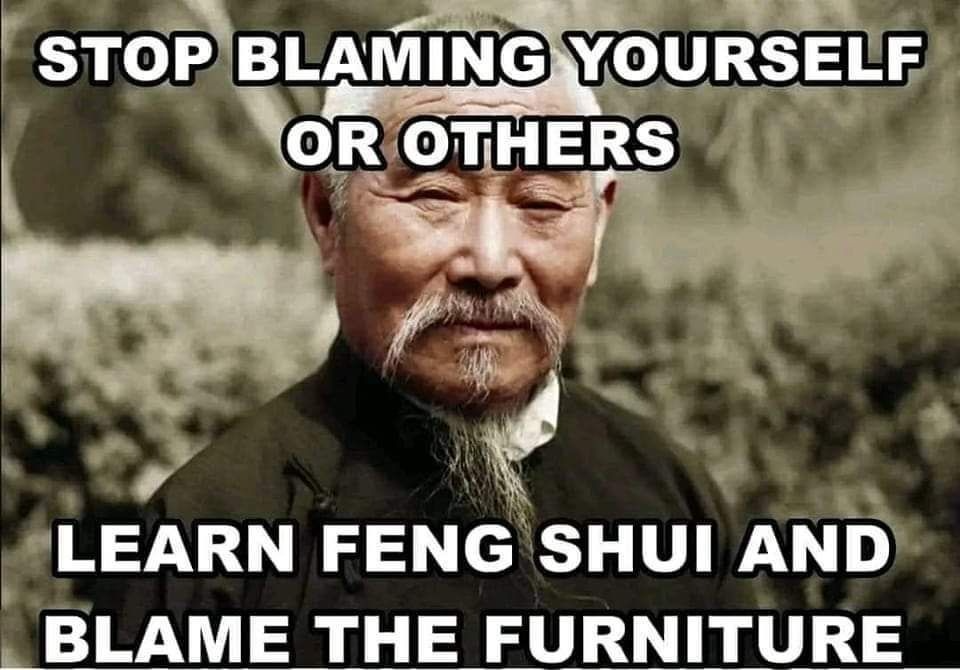The Armchair Configuration in Feng Shui and Prospect and Refuge Theory: Unifying Tradition and Evolution
Feng shui, an ancient Chinese practice, and Prospect and Refuge Theory, rooted in evolutionary psychology, may initially seem worlds apart. Yet, both share a profound insight into human interaction with space, emphasising the importance of creating environments that support well-being, prosperity, and security. We uncover a harmonious blend of tradition and science by exploring the armchair configuration (sometimes called commanding/power position) in feng shui alongside Prospect and Refuge Theory.
How does feng shui influence financial well-being without controlling it, and what can be done about a lack of support at the back of a property? And what can be done about it?
Topographic Benefits of the Armchair/Commanding/Power Configuration/Position
The armchair configuration in feng shui refers to the ideal positioning of a home or structure, supported from the back (like the back of an armchair), protected at the sides (the armrests), and open at the front. This setup offers topographical benefits, creating a natural shield against harsh elements while opening up to positive energies and opportunities. It mimics the natural inclination for sheltered spaces that offer a vantage point over the surroundings, ensuring a site is neither exposed to prevailing winds nor closed off from the nourishing sunlight.
The armchair configuration in feng shui is not only a matter of interior comfort but deeply intertwines with the topographical positioning of a home within its larger environmental context. This configuration seeks to replicate the natural protection and support provided by the landscape, an embodiment of the ancient feng shui principle of harmony between humanity and nature. The optimal siting of a home, according to this principle, mirrors the ideal conditions for a thriving existence, where energy (qi) is nurtured, and the elements are balanced for the benefit of its inhabitants.
A Historical Account of Feng Shui
Feng shui’s origins are deeply spiritual and practical, dating back over 3,000 years. Initially, it was grounded in the selection of grave locations for ancestral spirits, emphasising tranquillity and harmony between the deceased and the natural world. This practice evolved to encompass the living, guiding the placement and orientation of living spaces to harness the beneficial flows of qi (energy) and ensure prosperity and well-being for the inhabitants.
Integration of the Five Celestial Animals Theory
Expanding on the armchair configuration, the Five Celestial Animals Theory in feng shui introduces a sophisticated layer of environmental harmony, further emphasising the importance of topographical benefits. This theory, which includes the Black Tortoise at the back, the Red Phoenix in the front, the Green Dragon to the right, the White Tiger to the left, and the Yellow Snake at the centre, symbolises the ideal spatial relationships and energetic balance within a landscape.
- Black Tortoise (Back): The presence of a protective hill or a higher ground behind a property is likened to the Black Tortoise, offering stability, support, and protection from harsh winds and energies coming from the north. This aligns with the refuge aspect, providing a secure backdrop to the living space.
- Red Phoenix (Front): An open space or a lower ground in front of the property, symbolised by the Red Phoenix, invites opportunities, welcomes positive energy, and encourages prosperity. This openness aligns with the prospect aspect, offering a clear view of the horizon and incoming energies.
- Green Dragon (Right) and White Tiger (Left): To the sides, the Green Dragon and the White Tiger represent slightly elevated landforms or structures that are not as high as the tortoise at the back but higher than the phoenix at the front. These formations balance the masculine (yang) energy of the dragon and the feminine (yin) energy of the tiger, promoting harmony and balance in the living environment.
- Yellow Snake (Center): At the center, where the dwelling sits, is the Yellow Snake, symbolising Earth and the culmination of energies gathered from the surrounding celestial animals. This area is the heart of the home, where qi is harmonised and life flourishes.
Topographical Benefits and Applications of Commanding/Power Position
The armchair configuration, enriched by the Five Celestial Animals Theory, offers profound topographical benefits:
- Protection and Support: The Black Tortoise at the back and the flanking Dragon and Tiger provide a natural shield against environmental extremes, while also ensuring that the qi remains within the space, nurturing the inhabitants.
- Prosperity and Opportunity: The open space symbolised by the Red Phoenix allows for the flow of positive energy and opportunities into the home, promoting prosperity.
- Harmony and Balance: The arrangement of the celestial animals encourages a balanced flow of yin and yang energies within the space, contributing to the well-being and harmony of its residents.
Integrating the armchair configuration with the Five Celestial Animals Theory in feng shui not only aligns a home within its natural landscape for optimal energy flow but also taps into the primal human instinct for security (refuge) and potential (prospect). This sophisticated understanding of space and environment fosters a habitat that is not just physically secure but also energetically balanced, inviting prosperity, well-being, and harmony into the lives of its inhabitants.
Applications of Armchair Configuration in Bedrooms
In bedroom design, the armchair configuration promotes rest, privacy, and rejuvenation. Placing the bed so that it has a solid wall behind it, open space in front, and supportive energy on either side enhances personal comfort and a sense of security. This arrangement fosters better sleep quality, vital for physical and mental health, aligning with the feng shui belief in the bedroom as a crucial space for personal renewal.
Applications of Armchair Configuration in Workplaces
For workplaces, this configuration emphasises the importance of positioning desks and seating to encourage focus, productivity, and protection from distractions. A supportive backdrop and clear view of the entrance enable individuals to work with confidence, fostering an environment where creativity and efficiency can flourish. Make sure you have a good office chair with the soft support for the arms to give you even more power. By applying the armchair principle, workplaces become spaces of refuge and prospect, enhancing overall job satisfaction and performance.
Prospect and Refuge Theory as the Evolutionary Underpinning Philosophy
Prospect and Refuge Theory, introduced by Jay Appleton in 1975, posits that humans are instinctively drawn to environments that offer both opportunities for surveillance (prospect) and places of concealment or shelter (refuge). This theory, rooted in evolutionary psychology, suggests that these preferences are survival mechanisms that have been ingrained over millennia, providing strategic advantages in both hunting and evading predators.
The relevance of Prospect and Refuge Theory to the armchair configuration in feng shui is profound. Feng shui, with its emphasis on harmonising individuals with their surrounding environment, naturally incorporates elements that fulfil these innate human needs. The armchair configuration mirrors the theory’s principles by ensuring that the living space (be it a home or office) is supported at the back (refuge), has protective sides (further refuge), and an open front (prospect). This setup not only aligns with our deep-seated preferences for safety and observational advantage but also fosters a sense of well-being and security.
In the context of feng shui, the armchair configuration maximises the positive flow of qi or energy, ensuring that it circulates freely without escaping, thereby nurturing the inhabitants’ health, wealth, and happiness. This configuration is thought to create a space that is both empowering and comforting, allowing individuals to thrive.
The alignment between Prospect and Refuge Theory and feng shui underscores a universal truth about human-environment interactions: spaces that cater to our primal needs for protection and perspective promote psychological well-being and productivity. By designing environments that reflect these principles, we tap into the evolutionary logic that has shaped human preferences and behaviour, crafting spaces that are not only aesthetically pleasing but deeply resonant with our fundamental nature.
This synthesis of ancient wisdom and modern psychological understanding offers a powerful lens through which we can view our living and working environments. It highlights the importance of thoughtful design in creating spaces that support our innate needs, encouraging harmony between our inner selves and the outer world. Through the lens of Prospect and Refuge Theory, the armchair configuration in feng shui emerges not as a mere stylistic preference but as a manifestation of deep-seated human instincts, offering a pathway to balance, well-being, and fulfilment.
Feng Shui and Financial Well-being: Influence vs. Control and the Lack of Support at the Back of the Property
How does feng shui influence financial well-being without controlling it, and what can be done about a lack of support at the back of a property? And what can be done about it?
Feng shui provides a framework for arranging our environments in harmony with natural principles, potentially influencing aspects of our lives, including financial stability. It operates on the premise that certain spatial configurations, like a well-contained backyard, can enhance positive energy flow, indirectly supporting prosperity. However, it’s critical to distinguish between the influence feng shui can exert and the notion of control over financial outcomes.
Feng shui influences behaviour and mood by fostering environments that resonate with our innate preferences, such as security and openness, which may, in turn, support better focus, decision-making, and a positive outlook—factors that can indirectly contribute to financial well-being. But feng shui doesn’t control behaviour! Yet, the concept of control implies a direct causation that feng shui, or any environmental arrangement, cannot guarantee, especially regarding complex, multifaceted issues like financial stability.
“It’s akin to the feng shui myth that a toilet in the wealth corner (as per the bagua model) can ‘drain your finances’ or ‘flush away money’—which is, frankly, nonsense. Toilets don’t control your finances—you do.”
Financial challenges arise from a complex interplay of factors—economic conditions, personal choices, systemic issues, and more—beyond the scope of environmental influences. Recognising this distinction empowers us to appreciate feng shui’s potential benefits without overlooking the importance of proactive financial management and adaptation to broader economic realities.
In conclusion, having said that, environments, according to feng shui and Prospect-Refuge Theory, are designed to influence behaviour and outcomes by creating a conducive setting for positive energy flow and well-being. However, they do not control behaviour or dictate outcomes directly. Therefore, the idea that an open backyard directly causes financial issues oversimplifies the complex relationship between space design and life circumstances. It’s more accurate to view such environmental features as one of many factors that might influence, but not determine, financial success or failure.
Solutions
Addressing the feng shui concern of an open backyard—which is thought to potentially lead to financial instability or loss of energy (qi)—requires creative solutions that balance the need for openness with the principle of containment. Here are several feng shui strategies to harmonise an open backyard space, enhancing its energy while mitigating any negative impacts:
1. Create a Symbolic Boundary
Using plants, shrubs, or trees to outline the perimeter of your backyard can create a symbolic barrier without closing off the space entirely. Choose species that are evergreen to ensure year-round protection. This approach maintains the openness of the area while subtly defining the space’s edges, symbolically containing the qi.
2. Incorporate Water Features
Water features such as fountains or ponds, especially when placed near the backyard’s entrance, can attract positive energy and wealth, according to feng shui principles. The flowing water symbolises the flow of wealth and prosperity into the home and can act as a focal point to gather and circulate qi effectively.
3. Use Wind Chimes or Garden Sculptures
Strategically placed wind chimes can attract good energy and create a pleasant, harmonising sound that promotes the flow of qi. Similarly, garden sculptures can serve as focal points that draw attention and energy inward, preventing qi from escaping the backyard too quickly.
4. Implement Pathways and Curves
Designing pathways that meander through the backyard can guide the flow of energy throughout the space, preventing it from rushing straight through. Curved paths, as opposed to straight lines, encourage a gentle, meandering flow of qi, enhancing the space’s energy.
5. Elevate the Rear of the Yard
If possible, introduce a slight elevation at the back of the yard, mimicking the protective energy of the Black Tortoise—one of the celestial animals in feng shui. This can be achieved through landscaping, a raised garden bed, or even a row of taller plants or trees. This elevation acts as a supportive backdrop, symbolically protecting the home and containing energy.
6. Add Lighting for Evening Balance
Strategically placed outdoor lighting can energise the backyard at night, ensuring the space remains vibrant and filled with positive energy even after sunset. Lights can also highlight key features or plants, contributing to the overall balance and harmony of the space.
7. Regular Maintenance
Keeping the backyard well-maintained is crucial in feng shui. Overgrown plants, clutter, and unkempt areas can stagnate the flow of qi. Regularly tending to the garden, clearing debris, and ensuring the space is inviting and clean promotes a healthy, positive energy flow.
What if I can’t do anything about my backyard and I think its “causing” my problems?
Adopting the viewpoint that an open-air backyard is “causing” your problems can lead to a ‘false problem,’ distracting from addressing actionable factors within your control.
If you don’t feel supported in life, consider designing other environmental features that can offer you such support. For instance, examine your bedroom or workplace (see above about bedrooms and workplaces) setup to ensure it follows supportive feng shui principles, like positioning your bed or desk to have a solid wall behind you for stability (emulating the armchair configuration). Also, placing armchairs in strategic positions within living spaces can create a sense of security and comfort. Beyond feng shui, explore other design philosophies and practices that enhance your environment’s positive impact on your well-being, such as incorporating plants for biophilic benefits, using colours that uplift your mood, and ensuring ample natural light. Creating a personalised space that reflects your needs and preferences can profoundly influence your sense of support and overall well-being.
Cultivate a feeling of being supported by engaging in practices that strengthen your connection to your environment and community. This could involve creating a personal sanctuary space where you feel at ease, participating in community gardening or local events to foster a sense of belonging, and practicing mindfulness or meditation to enhance your awareness and appreciation of your surroundings. By actively choosing to enrich your relationship with your environment and those within it, you can build a foundation of support that transcends physical spaces.
By applying these feng shui solutions, an open backyard transforms from a potential source of energy loss into a vibrant, harmonious extension of the home that supports prosperity and well-being. Each strategy works to subtly contain and nurture the flow of qi, aligning with the principles of balance and harmony that are central to feng shui.
Conclusions
The armchair configuration in feng shui, supported by the insights of Prospect and Refuge Theory, highlights a universal truth: environments profoundly influence our well-being, productivity, and sense of security. By harmonising these practices, we can create spaces that not only cater to our innate needs for shelter and perspective but also foster a deeper connection with the natural world. In bridging the gap between tradition and science, we find timeless principles for designing spaces that resonate with our deepest human instincts, promoting a life of harmony, prosperity, and well-being.
References
Appleton, J. (1975). The Experience of Landscape. London: Wiley.
Appleton introduces Prospect and Refuge Theory, explaining the evolutionary basis for human preferences in landscapes and built environments.

